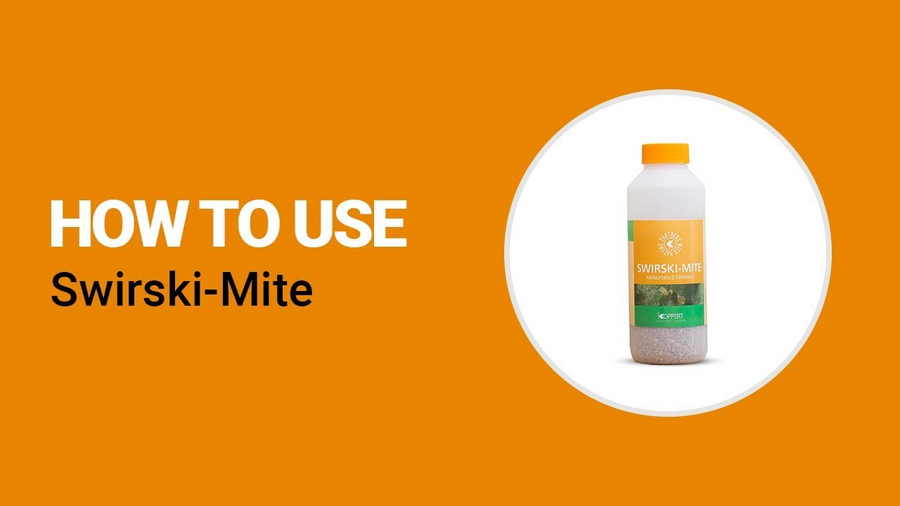Amblyseius swirskii is a species of predatory mite widely employed for biological pest control in agriculture. The predatory mite is an excellent biocontrol agent of thrips and whiteflies. Amblyseius swirskii can also survive on pollen and other prey and can establish in the crop before the pest appears. These predatory mites are employed as part of integrated pest management (IPM) strategies, offering a sustainable and environmentally friendly alternative to chemical pesticides.
Amblyseius swirskii for pest control
Amblyseius swirskii is used for the control of the following pests:
Amblyseius swirskii mites actively seek out and prey on young larvae of various thrips species and whitefly eggs and larvae. By consuming multiple life stages of these pests, Amblyseius swirskii effectively controls thrips and whitefly.
Feeding behaviour of Amblyseius swirskii
Predatory mites pierce their prey and suck out the contents. In addition to thrips and whiteflies, Amblyseius swirskii preys on several other small organisms such as spider mites and tarsonemid mites. They can also feed on pollen, which is useful for instance in sweet pepper crops as the predatory mite can establish in the crop before the pest appears. Amblyseius swirskii mainly preys on first instar larvae of thrips and young eggs, crawlers and second instar larvae of whiteflies. At 25°C under optimal conditions, an adult female Amblyseius swirskii lays 2.3 eggs per day with Trialeurodes vaporariorum eggs as prey. Under the same conditions, it can consume 4 Western Flower Thrips (Frankliniella occidentalis) larvae per day and lay 1.4 eggs per day on this prey
Life cycle of Amblyseius swirskii
The life cycle of Amblyseius swirskii consists of egg, larva, protonymph, deutonymph, and adult. Eggs are laid on the underside of leaves, often in the axil of veins. They are oval, white and are approximately 0.14 mm in diameter. The larvae have six legs, are the same colour as the eggs, and are only slightly larger. The larvae of Amblyseius swirskii do not need to feed. The nymphs are larger than the larvae, have eight legs, and are a whitish yellow colour. Adult mites have eight legs, are a translucent white in colour, and have a flat, elongated body. They are roughly 0.4 mm in length. Males are smaller than females. The mites are very mobile and actively search for food on the underside of leaves. They often congregate in the axils of leaf veins to rest. Their colour can vary according to the prey eaten, and varies from almost lucent whitish to opaque white or yellow. Due to their size and colour they are difficult to spot in the crop.
Best conditions for use of Amblyseius swirskii
Amblyseius swirskii is most effective at temperatures between 20 and 32°C (68 and 90°F). It is not effective at temperatures below 18°C/64°F. Amblyseius swirskii is sensitive to relative humidity below 60%.
In tomato, use of Amblyseius swirskii is not recommended as it is hindered by the glandular hairs on the stems and leaves and does not build up a population.
Amblyseius swirskii in bottles
The predatory mite Amblyseius swirskii is available in a bottle (Swirski-Mite).
- Turn and shake the bottle gently before use
- Push the centre of the cap to open the dosage hole
- Sprinkle material on leaves or pour into Diboxes
- Make sure the material remains on the introduction site for at least a few hours after introduction
- Can also be applied with (Mini)-Air(o)bug
The dosage of Swirski-Mite depends on climate, crop and pest density and should always be adjusted to the particular situation. Start introduction as soon as the first pest mites are detected in the crop. Introduction rates typically range from 25-300 per m2/release. Releases should be repeated if necessary. Consult a Koppert advisor or a recognized distributor of Koppert products for advice on the best strategy for your situation.
Amblyseius swirskii in sachets
The predatory mite Amblyseius swirskii is also available in breeding sachets (Swirski-Mite LD, Swirski-Mite Plus, Swirski Ulti-Mite). In this case the predatory mites multiply in the sachet and disperse into the crop over a period of several weeks.
- Hang sachets in sheltered locations in the crop, not exposed to direct sunlight
- Sachets already have an exit hole
- Hold sachets by the cardboard strip at the top, to avoid damaging the predatory mites
The dosage of Swirski-Mite LD, Swirski-Mite Plus, Swirski Ulti-Mite depends on climate, crop and pest density and should always be adjusted to the particular situation. Start introduction preventively or as soon as the first pest mites are detected in the crop. Use at least 4,000 sachets per ha and hang them evenly spaced in the crop. Release should be repeated after 4 weeks if the pest is not controlled. Consult a Koppert advisor or a recognized distributor of Koppert products for advice on the best strategy for your situation.


